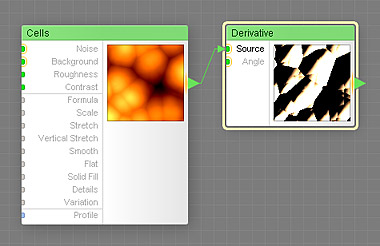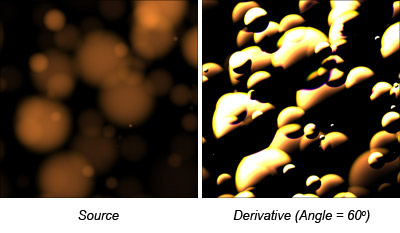
The Derivative component calculates the channel-wise directional derivative of a surface specified by its Source input along the direction specified by its Angle input. To produce one output sample, Derivative takes two samples of its Source input. The samples are located on a line passing through the original sample point to the right and to the left of it (the distance between these two samples is very small). Each output color channel is calculated as a difference between the two sampled channel values divided by the distance between the sample points. The resulting alpha channel is calculated by averaging the alpha channel values of the two samples.

Derivative can be used for detecting edges, simulating snow or dust-covered surfaces, assembling custom normal maps, or creating advanced lighting effects.
Derivative is a map component, it can be located in the RGB Math category on the Components Bar. This component can output HDR colors. Like other RGB Math components, this component processes its inputs on a channel-wise basis, treating RGB channel values as signed floating-point numbers. For more information, see How Math Components Work.
Source: Map Input (HDR), Required
Provides the channel-wise surface height. Derivative treats the input image as three height maps (one for each of the RGB channels) and calculates the surface slope for a specified "viewing angle" – the steeper the slope, the brighter the output. Source is a required input – in order to make Derivative work, this input must be connected. This input can accept HDR colors.
Specifies the angle for calculating the derivative. This input can accept HDR colors.